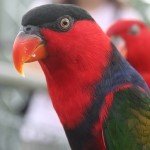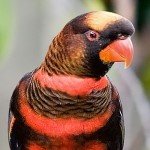LORIKEETS And LORIES
Lorikeets and Lories are beautiful and unique friends
Lories and Lorikeets are special birds that are different from other members of the parrot tribe.
There is no scientific difference between the two names–only that Lories have shorter tails while Lorikeets have longer tails. There are approximately 55 different species of these birds, but only about 12 are kept as pets. The most popular is the Rainbow Lory.
Lories are different from other parrots in that they eat nectar and pollen instead of seed. Because of their specialized diets, Lories don’t make good pets for first-time bird owners.
Lories are very playful, acrobatic, and curious. They can even learn to talk and many have good vocabularies.
They are also very social and seem to love everyone–they won’t bond to just you. The first time we came in contact with a Lory was at the Lory exhibit at the San Diego Wild Animal Park. The Lories are in an aviary where you can walk in and feed them nectar. We didn’t even purchase nectar at the time, but one Lory readily stepped up onto my finger. They are very friendly and it’s obvious that they make great companions. The only real drawback is their specialized diet.
If you are able to provide a Lory with adaquate care and their specialized diet, then this might be the right bird for you.
Lorikeets and Lories Info:
| Name | Lory (Trichoglossus) |
| Origin | Indonesia, New Guinea, and Australia |
| Size | 10-12 in., depending on species |
| Color Differences | The different species range in color from red to green, blue, and black. Many have multi-colored feathers. |
| Average Cost | $300-900 |
| Lifespan | Up to 20 years |
| Noise | Low–they are relatively quiet, so they are fine to live in an apartment with you. |
| Qualities | Active, curious, plaful, acrobatic, love to bathe, have brush-tongues, need special care and feeding, friendly, outgoing, active, clownish, love to hang upside down, aggressive toward other birds, seem to love everyone (don’t bond to just one person). |
| Abilities | Good–They are capable of talking and many have good vocabularies (their voices are high pitched and clear). They are also good whistlers. |
| Interaction/Time Requirements | Because Lories have specialized diets, this does take extra time. |
| Diet | Lories feed on pollen and nectar, so these need to be a part of your Lory’s diet. A dry powder that mixes with water is now available that makes providing this special food easier for bird owners. Just make sure you change the food often and also provide them with the diet for medium birds as well. Here are some Lory diet products we recommend: |
| Supplies Needed | Lories need supplies for medium birds. |
Types of Lories

Black-Cap

Dusky

Blue-Streak

Rainbow

